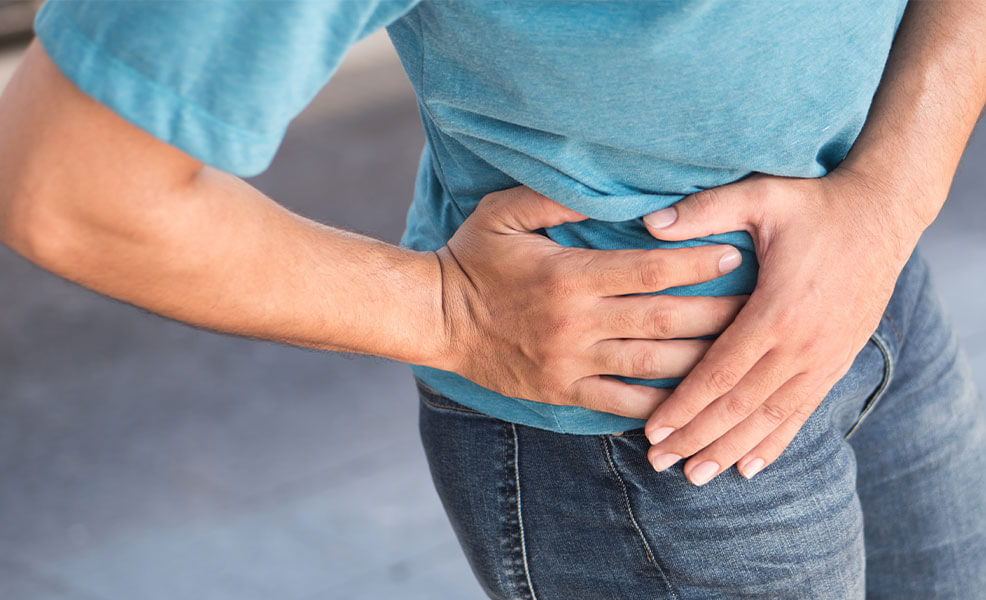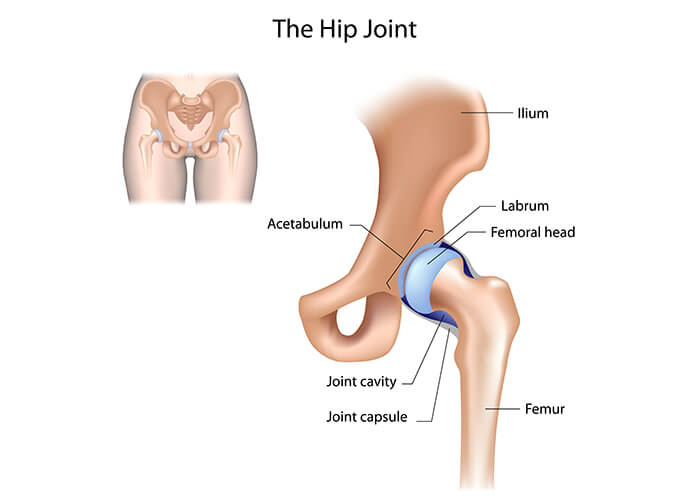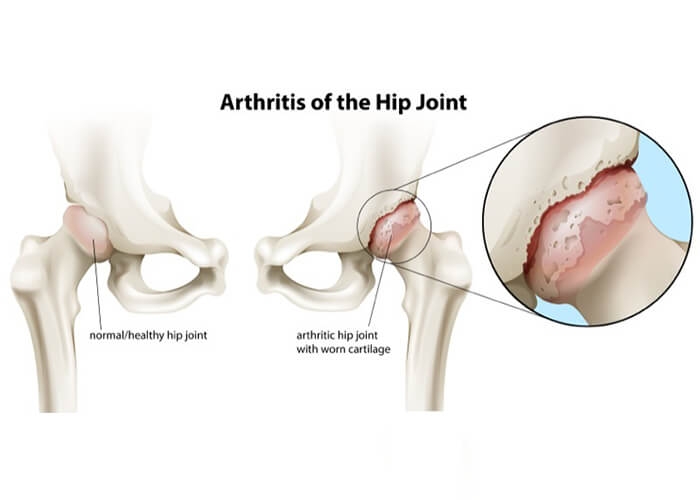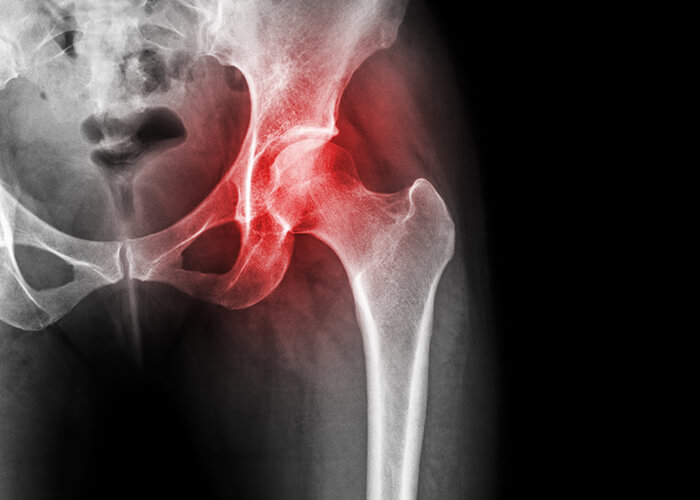
Hip pain is a common painful condition that’s usually felt in or around the hip joint, especially in older adults. It occurs from various causes, including trauma, overuse, bursitis, ageing, and in younger patients, early degeneration.
It can cause pain of an acute or chronic nature which often can be intermittent, or worsen at certain times of the day.
Pain radiating into the groin is usually a sign of a problem within the hip joint itself— and any pain outside the hip can be associated with problems in the muscles, ligaments, tendons or structures surrounding the hip joint such as the bursa. Pain which is referred outside the hip may also be coming from the lower back with Sciatica often presenting this way
A Brief Anatomy of the Hip Joint
The hip joint is one of the largest joints in the body. It supports the body weight and movement of the legs.
Within the pelvic area, the hip joint is a ball and socket synovial joint. The hip joint connects the trunk of the body to the lower limbs. It is therefore extremely strong, stable and flexible.
The hip joint consists of two main parts, a ball (femoral head) and a socket (acetabulum). The femoral head of the femur (thigh bone) attaches itself to the rounded socket (acetabulum) inside the pelvis. The ball moves inside the socket allowing the leg to be mobile and move in many directions depending on the movement required.

This large weight-bearing joint is covered by cartilage, ligaments, muscles and tendons for maximum support. Smooth fibrous tissue known as articular cartilage lines the socket and head of the femur. The cartilage acts as a cushion and a gliding surface to allow movement of the bones within the hip joint
A structure called synovium surrounds the remaining area of the hip joint. This synovial membrane produces fluid termed synovial fluid which lubricates the hip joint and reduces friction. This ensures the smooth gliding motion of the structures within the hip joint itself.
There are also three strong ligaments that attach the femur bone to the acetabulum, the iliofemoral, pubofemoral ligament and the ischiofemoral ligament.
Despite its robustness, the hip joint is not free from age-related degeneration and other injuries, which can result in significant hip pain.
Hip pain can also be caused by a range of conditions including bursitis, and referred pain from trapped nerves from other sites such as the lumbar region. Therefore, if you experience recurring pain or discomfort in your hip area, consult a doctor. You will need a back and hip examination and possible imaging tests such as an MRI or XRAY.
Causes of Hip Pain
Hip pain can be a result of various causes and can occur at any age. Some of the most common causes of hip pain are:
Hip Arthritis: Osteoarthritis and rheumatoid arthritis are the most common causes of hip pain. While both conditions lead to the breakdown of cartilage and inflammation of the hip joints, osteoarthritis is mostly age-related. The pain gets worse with time and affects the range of motion in the hips. Arthritis associated with Rheumatoid Arthritis can cause hip pain due to effusions within the hip joint. This can also present with pain and stiffness first thing in the morning
Hip Labral Tear: Any tear or injury in the Labrum (covering the acetabulum) may cause hip pain. The pain from a hip labral tear increases when you move, bend or rotate the hip.

Femoroacetubular Impingement: Femoroacetubular impingement (FAI) is a painful condition in which the femoral head does not fit properly into the socket (Acetabulum), This causes hip pain., especially during hip movements such as flexion and adduction.
Greater Trochanteric Bursitis: An inflammation of the bursa, which is a fluid-filled sacthat acts as a cushion at the joints near the outside of the hip, the greater trochanter, also causes hip pain on the outside of the hip. The greater trochanteric bursitis is now more commonly referred to as Greater Trochanteric Syndrome. This is because actual bursitis is rarely the cause of the pain
The condition is actually more commonly associated with gluteus medius tendinopathy. This condition is caused by prolonged use or degeneration of the gluteal muscle tendon, which can on occasion also cause bursitis.
Hip Fractures: Hip fractures from a fall is another frequent cause of hip pain, especially in older people due to factors such as inadequate calcium intake, prolonged steroid use, smoking, osteopenia and osteoporosis.
Tendinitis: Repetitive activities or stress causes an injury or inflammation of the tendons at the hip joint causing hip pain.
Avascular Necrosis: This condition, also called osteonecrosis, occurs when the hip bone tissue dies due to poor blood flow.
Snapping Hip Syndrome: Snapping hip is often due to external structures such as the iliotibial band snapping over the greater trochanter of the femur. It can also be caused by the iliopsoas tendon snapping over the bony prominence of the pelvis. There are also internal causes which may cause Snapping hip Syndrome.
Cancers: Tumours in the bone also cause hip pain along with pain in other bones.
Symptoms of Hip Osteoarthritis
Hip Osteoarthritis usually presents as a dull or severe pain in the groin region. Over time, the pain can also radiate to the lower back, buttocks, thighs and knee.

Common symptoms of Hip Osteoarthritis
- Pain or stiffness in the hip while standing, walking or moving
- Severe pain that causes difficulty while walking or sleeping on the hip
- Reduced range of motion in the hips
- Discomfort or severe pain that radiates into thighs or buttocks
- Swelling or pain after a log walk or running
Diagnosis of Hip Pain

To diagnose hip pain, your doctor will begin by taking a medical history, followed by a physical examination. They will ask you to walk and assess your gait. You will also be examined for the range of motion and any stiffness or tenderness in the hip.
Your doctor will then ask for imaging tests like X-rays, MRIs, CT scans or ultrasounds to check for arthritis or other conditions. They may also ask you for fluid tests like samples of blood (if an inflammatory condition is suspected) or joint fluid.
Treatment of Hip Pain
Your doctor will recommend a treatment based on the cause and symptoms of your hip pain. The treatment for hip pain includes:
Painkillers
Several over-the-counter medications like naproxen, ibuprofen and paracetamol help relieve hip pain.
Cortisone Injections
Cortisone injections help relieve pain, swelling and inflammation from hip pain especially Arthritis. It is also used with great efficacy in Hip Bursitis
Hyaluronic Acid Injection (Ultrasound Guided intra articular Hip Injection)
Hyaluronic acid injections e.g Ostenil Injections play an effective role in treating hip pain due to Arthritis. At our clinic, An Ostenil injection is often administered to replace the synovial fluid in the hip joint which may have degraded over time due to the degeneration within the hip joint. Evidence has shown Injecting hyaluronic acid improves hip joint function and reduces pain. Our choice of Hyaluronic Acid for this procedure is Ostenil Plus. We are an Ostenil Approved Clinic via the Official UK distributor of Ostenil, TRB Chemedica UK
PRP
Platelet-rich plasma therapy is effective in relieving hip pain from hip arthritis. It is thought it reduces hip stiffness and pain by improving the body’s natural regenerative capabilities to create new cartilage tissue.
Prolotherapy
Prolotherapy is an excellent treatment to relieve chronic hip pain from hip arthritis, labral tears and Femoroacetabular impingement.
Physical Therapy
Physical therapy exercises like stretching, joint mobilisation, and gait training help relieve pain and improve the strength and mobility of hip joints.
Surgery
Surgery is usually preferred after conservative measures have failed.
Final Thoughts
Hip pain is common, and you must be careful if it keeps becomes troublesome or persistent. With timely diagnosis and treatment, in many cases it can be treated.
Consult our Osteopath in our Burnley Clinic at MyMSK clinic if you are located in the Lancashire area.
If you are based in the Cheshire/Greater Manchester region, we are able to offer Consultations at our Manchester Clinic.
If your hip pain is causing you discomfort especially when weightbearing or during sleep or if it is stopping you from doing your daily activities, we are here to help.
FAQ
How do I know if my hip pain is serious?
If you experience intense pain in the hip area along with discomfort while moving or standing, you should seek medical help urgently. Hip pain with sudden swelling, redness, fever or chills can indicate a serious problem. In this happens please go to the nearest urgent care centre
How do I know if I have hip arthritis?
If you have hip arthritis, your hip feels painful, stiff and limited in motion. Your pain increases when you walk for a long time, climb stairs or work out. Some people also experience a snapping or clicking sound within the hip.
Is prolotherapy an effective treatment for hip pain?
Yes, prolotherapy is an excellent treatment for treating chronic hip pain from degenerative conditions. It helps relieve hip pain from arthritis and hip labral tears and other degenerative conditions. In most cases, it also avoids the need for hip surgery.
What is the best injection for hip pain?
Both corticosteroid injections and hyaluronic acid injections are good options for treating hip pain. Depending upon your symptoms, your doctor will examine you carefully and make a recommendation.
How long does it take to see improvements after PRP injection?
After injecting PRP into your hips, it usually takes two to six weeks for your hips to show improved mobility and function. PRP works by releasing a natural substance called platelets to heal the damaged area. This substance promotes the growth and healing of degenerative faster.




